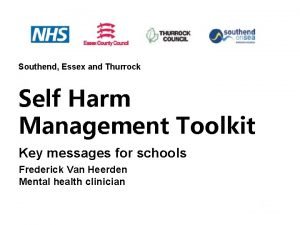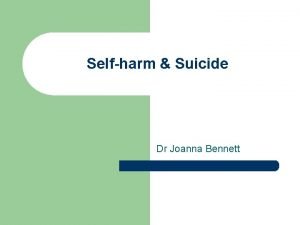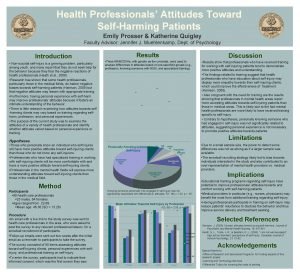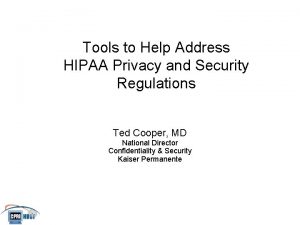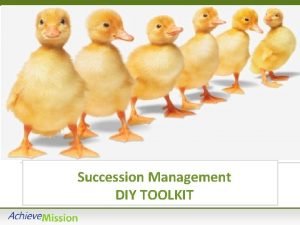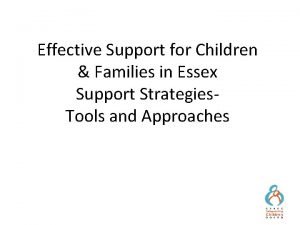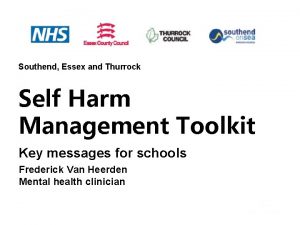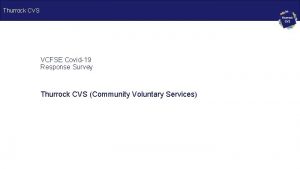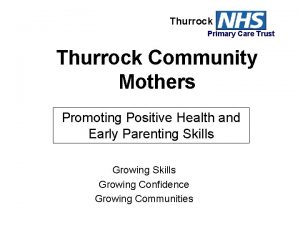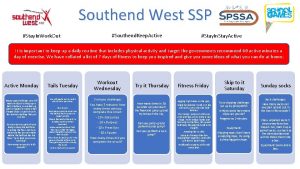Southend Essex and Thurrock Self Harm Management Toolkit









- Slides: 9

Southend, Essex and Thurrock Self Harm Management Toolkit Key Messages Cascade Pack for Schools

What is Self Harm? The term “self-harm” is used to describe a wide range of behaviours. Self-harm is often understood to be a physical response to an emotional pain. It can be seen as an intentional act of damaging or injuring one’s body, irrespective of apparent motivation, though is usually a way of expressing or coping with overwhelming emotional distress. Video from Mind around information on Self Harm: https: //www. youtube. com/watch? v=f. SEt. Ubc 8 JDU

Introduction • The purpose of this session is to provide an introduction to and create awareness around the Self Harm Management Toolkit, its contents and how to use it. • In March 2015 NHS England the Department of Health published Future in Mind a national ambition to transform services for children and young people with mental health needs. • Early intervention is a key focus of this and the local CYP MH strategy – Open Up, Reach Out. • Schools shared that self-harm in young people is becoming a more prevalent issue • In response, local authorities (a multi-agency working group) put together the toolkit to support staff around responding and supporting CYP who self harm. • https: //www. youtube. com/watch? v=u. KGci. UB 8 OSg

Aims of the Self Harm Management Toolkit • Increase school staff understanding and awareness of emotional wellbeing difficulties for young people; • Support staff to be aware of risk factors and signs that are associated with emotional distress self-harming behaviour in young people; • Provide guidance for educational settings (and staff within them) dealing with students who present with emotional distress and self-harming behaviour; • Raise awareness in educational settings of what support is available locally in dealing with young people who find themselves in emotional turmoil • Provide online support references to school staff, parents and young people

Toolkit – Key Sections Spotting the signs How do you respond Assessing risk Confidentiality and information sharing Talking to children and young people Do’s and Don’ts Distraction/coping strategies Activity – Split into pairs/groups, review information in the Toolkit section; discuss in your pairs/tables and identify 2 key elements that you want to share back with the group.

Roles and Responsibilities • What is your individual responsibility? • What is in place to help you manage this? • Our own school safeguarding procedures; what do we do in house/support child young person to do, how do we escalate through our own safeguarding routes?

Key Dos – Full Details Page 15 Toolkit • Make time. Talk to the child or young person about their selfharming. • Listen to what is being said and check your understanding • Respond with concern rather than anxiety or distaste • Find out how they are feeling – are there ups and downs? Are there underlying difficulties? • Ask about existing coping strategies and suggest additional strategies • Act appropriately in line with policy of confidentiality • Speak to other agencies or nominated people within the parameters of confidentiality • Look after yourself; ensure you have someone to support you and talk things through with

Key don’ts – Full details page 15 Toolkit • Don’t tell them to stop self-harming or give them an ultimatum • Do not ignore self-harm however superficial it may seem to you, or assume someone else is already helping them • Do not make judgements or promises you can’t keep

Additional support/resources available Please make use of the extensive support and advice contained within the Toolkit. The appendices section contains a wealth of information and support around CYP mental health. Activity a)– split into small points and review the appendices. Pick 1 or 2 that you can give an example of being useful in the past or will be in the future. Activity b) – discuss with your group how you are going to start to use and embed the Toolkit within your own practice.
